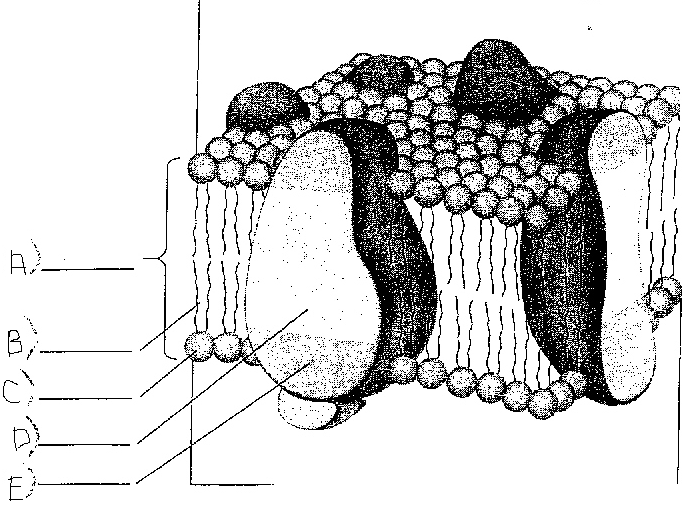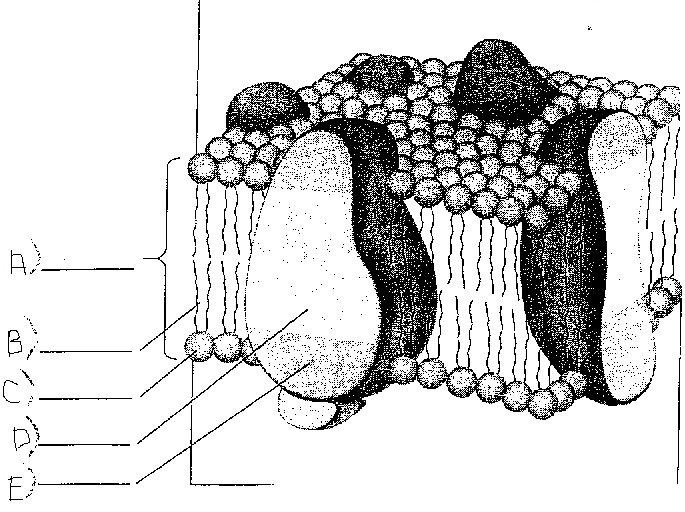Membrane Structure And Function

This quiz covers our lesson over membrane structure and function.
- 1.
Which one represents facilitated diffusion?
- A.
I
- B.
II
- C.
III
- D.
I and II
- E.
I and III
Correct Answer
B. IIExplanation
Facilitated diffusion is the process by which molecules pass through a cell membrane with the help of transport proteins. Option II represents facilitated diffusion because it shows a molecule passing through a cell membrane with the assistance of a transport protein. Option I does not show any transport protein, and option III does not show a molecule passing through a cell membrane. Therefore, option II is the correct representation of facilitated diffusion.Rate this question:
-
- 2.
Does a cell expend energy for facilitated diffusion?
- A.
Yes
- B.
No
- C.
Sometimes
Correct Answer
B. NoExplanation
Facilitated diffusion is a passive process where molecules move across the cell membrane with the help of transport proteins. Unlike active transport, facilitated diffusion does not require the cell to expend energy in the form of ATP. Therefore, the correct answer is "No."Rate this question:
-
- 3.
Which one shows active transport?
- A.
I
- B.
II
- C.
III
- D.
I and II
- E.
I and III
Correct Answer
C. IIIExplanation
Option III shows active transport because it indicates that active transport is occurring in both I and III. Since the question asks for the option that shows active transport, we can conclude that option III is the correct answer.Rate this question:
-
- 4.
Which one shows diffusion?
- A.
I
- B.
III
- C.
I and III
Correct Answer
A. IExplanation
Option I shows diffusion because it is the only option that indicates the movement of particles from an area of higher concentration to an area of lower concentration. Diffusion is the process by which molecules or particles spread out and mix with other substances due to their random motion. Option III does not show diffusion as it suggests the movement of particles in a specific direction, which is not characteristic of diffusion.Rate this question:
-
- 5.
Which of these is/are considered passive transport?
- A.
I, not II
- B.
II, not I
- C.
I and II
- D.
I and III
- E.
I, II, and III
Correct Answer
C. I and IIExplanation
Passive transport is the movement of substances across the cell membrane without the use of energy. Option I refers to diffusion, which is the movement of molecules from an area of high concentration to an area of low concentration. Option II refers to facilitated diffusion, which is the movement of molecules across the membrane with the help of transport proteins. Both of these processes do not require energy and are considered examples of passive transport. Therefore, the correct answer is I and II.Rate this question:
-
- 6.
A solution of 1 M glucose is separated by a selectively permeable membrane from a solution of 0.2 M fructose and 0.7 M sucrose. The membrane is NOT permeable to the sugar molecules, only to water. Indicate which side is initially hypertonic to the other side.
- A.
Side A
- B.
Side B
- C.
Neither A nor B
Correct Answer
A. Side AExplanation
In this scenario, a solution of 1 M glucose is separated from a solution of 0.2 M fructose and 0.7 M sucrose by a selectively permeable membrane. The membrane only allows the passage of water molecules, not sugar molecules. Hypertonicity refers to the concentration of solutes in a solution. Since side A has a higher concentration of solutes (1 M glucose) compared to side B (0.2 M fructose and 0.7 M sucrose), side A is initially hypertonic to side B.Rate this question:
-
- 7.
Facilitated diffusion across a cellular membrane requires ______________ and moves a solute ______________ its concentration gradients.
- A.
Energy and transport proteins; down
- B.
Energy and transport proteins; against
- C.
Energy; against
- D.
Transport proteins; down
- E.
Transport proteins; up
Correct Answer
D. Transport proteins; downExplanation
Facilitated diffusion is a passive process that does not require energy. It involves the use of transport proteins to move solutes across a cellular membrane. These transport proteins help solutes move down their concentration gradients, from an area of higher concentration to an area of lower concentration. Therefore, the correct answer is "transport proteins; down."Rate this question:
-
- 8.
The fluidity of membranes in a plant in cold weather may be maintained by
- A.
Increasing the number of phospholipids with saturated hydrocarbon tails.
- B.
Activating an H+ pump.
- C.
Increasing the concentration of cholesterol in the membrane.
- D.
Increasing the proportion of peripheral proteins.
- E.
Increasing the number of phospholipids with unsaturated hydrocarbon tails.
Correct Answer(s)
C. Increasing the concentration of cholesterol in the membrane.
E. Increasing the number of pHospHolipids with unsaturated hydrocarbon tails.Explanation
The fluidity of membranes in a plant in cold weather may be maintained by increasing the concentration of cholesterol in the membrane and increasing the number of phospholipids with unsaturated hydrocarbon tails. Cholesterol helps to prevent the membrane from becoming too rigid by disrupting the packing of phospholipids. Unsaturated hydrocarbon tails in phospholipids introduce kinks in the fatty acid chains, which increases the fluidity of the membrane. Together, these mechanisms help to maintain the fluidity of membranes in cold weather conditions.Rate this question:
-
- 9.
A plant cell placed in a hypotonic environment will
- A.
Plasmolyze.
- B.
Shrivel.
- C.
Become turgid.
- D.
Become flaccid.
- E.
Lyse.
Correct Answer
C. Become turgid.Explanation
When a plant cell is placed in a hypotonic environment, it means that the surrounding solution has a lower concentration of solutes compared to the cell's cytoplasm. As a result, water moves into the cell through osmosis, causing the cell to swell and become turgid. This is because the cell wall prevents the cell from bursting. The option "become turgid" accurately describes the response of a plant cell in a hypotonic environment.Rate this question:
-
- 10.
The fluid mosaic model describes biological membranes as consisting of
- A.
A phospholipid bilayer with proteins sandwiched between the layers.
- B.
A lipid bilayer with proteins coating the outside of this hydrophobic structure.
- C.
A phospholipid bilayer with proteins embedded in and attached to it.
- D.
A protein bilayer with phospholipids embedded in it.
- E.
A cholesterol bilayer with proteins embedded in the hydrophobic center.
Correct Answer
C. A pHospHolipid bilayer with proteins embedded in and attached to it.Explanation
The fluid mosaic model describes biological membranes as consisting of a phospholipid bilayer with proteins embedded in and attached to it. This model suggests that the phospholipid molecules form a fluid-like bilayer, with the hydrophilic heads facing the watery environment and the hydrophobic tails facing inward. Proteins are embedded within this bilayer, some spanning across it and others attached to the inner or outer surface. This arrangement allows for the selective transport of molecules, cell recognition, and communication between cells.Rate this question:
-
- 11.
Pinocytosis involves
- A.
The fusion of a newly formed food vacuole with a lysosome.
- B.
Receptor-mediated endocytosis and the formation of vesicles.
- C.
The pinching in of the plasma membrane around small droplets of external fluid.
- D.
Pseudopod extension as vesicles move along the cytoskeleton and fuse with the plasma membrane.
- E.
The accumulation of specific large molecules in a cell.
Correct Answer
C. The pinching in of the plasma membrane around small droplets of external fluid.Explanation
Pinocytosis is a form of endocytosis where the cell takes in small droplets of external fluid by pinching in the plasma membrane. This process allows the cell to engulf and internalize extracellular fluid and any solutes present in it. Unlike receptor-mediated endocytosis, pinocytosis is non-specific and does not require specific receptors on the cell surface. It is a way for the cell to sample its environment and obtain necessary nutrients or molecules dissolved in the extracellular fluid.Rate this question:
-
- 12.
Which of the following letters consists of areas that have both hydrophilic and hydrophobic parts?
- A.
A
- B.
B
- C.
C
- D.
D
- E.
E
Correct Answer
A. AExplanation
Letter A consists of areas that have both hydrophilic and hydrophobic parts.Rate this question:
-
- 13.
Which of the following areas consists of a protein's hydrophobic section?
- A.
A
- B.
B
- C.
C
- D.
D
- E.
E
Correct Answer
D. DExplanation
The correct answer is D. The hydrophobic section of a protein refers to the part of the protein that is repelled by water and tends to be nonpolar. This region is typically composed of hydrophobic amino acids, such as alanine, leucine, and phenylalanine. It is commonly found in the interior of the protein, away from the surrounding aqueous environment. The hydrophobic section plays a crucial role in protein folding and stability, as well as in protein-protein interactions.Rate this question:
-
Quiz Review Timeline +
Our quizzes are rigorously reviewed, monitored and continuously updated by our expert board to maintain accuracy, relevance, and timeliness.
-
Current Version
-
Mar 21, 2023Quiz Edited by
ProProfs Editorial Team -
Sep 20, 2009Quiz Created by
Staylor98
 Back to top
Back to top








